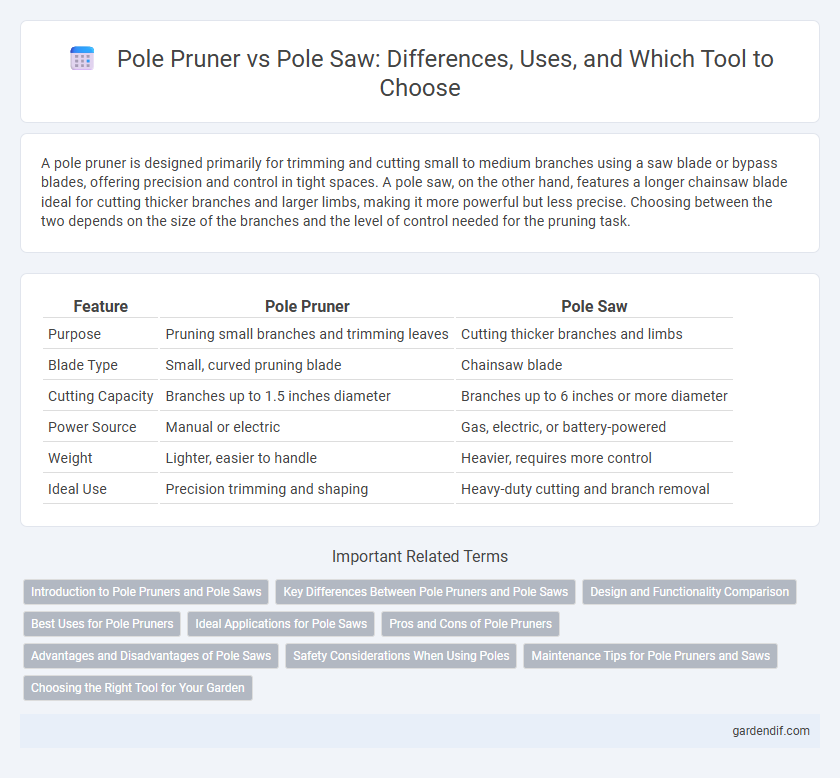
Pole pruner vs pole saw Illustration
A pole pruner is designed primarily for trimming and cutting small to medium branches using a saw blade or bypass blades, offering precision and control in tight spaces. A pole saw, on the other hand, features a longer chainsaw blade ideal for cutting thicker branches and larger limbs, making it more powerful but less precise. Choosing between the two depends on the size of the branches and the level of control needed for the pruning task.
Table of Comparison
| Feature | Pole Pruner | Pole Saw |
|---|---|---|
| Purpose | Pruning small branches and trimming leaves | Cutting thicker branches and limbs |
| Blade Type | Small, curved pruning blade | Chainsaw blade |
| Cutting Capacity | Branches up to 1.5 inches diameter | Branches up to 6 inches or more diameter |
| Power Source | Manual or electric | Gas, electric, or battery-powered |
| Weight | Lighter, easier to handle | Heavier, requires more control |
| Ideal Use | Precision trimming and shaping | Heavy-duty cutting and branch removal |
Introduction to Pole Pruners and Pole Saws
Pole pruners and pole saws are essential tools for maintaining trees and tall shrubs by allowing users to reach high branches safely. Pole pruners typically feature a long handle with a pruning blade or a rope-operated bypass cutter designed for cutting smaller branches up to 1.5 inches in diameter. Pole saws, often equipped with a chainsaw blade, are more powerful and suitable for cutting larger branches, making them indispensable for heavy-duty tree maintenance and removal tasks.
Key Differences Between Pole Pruners and Pole Saws
Pole pruners feature a long pole with a cutting blade or bypass shear designed for trimming thin branches up to 1.5 inches in diameter, providing precise cuts without damaging the tree. Pole saws have a chainsaw attachment at the end of an extended pole, ideal for cutting thicker branches and limbs over 2 inches in diameter with power and speed. While pole pruners are lightweight and suited for detailed pruning, pole saws are heavier and used for more heavy-duty tree maintenance tasks.
Design and Functionality Comparison
Pole pruners feature a long pole with a cutting blade or small saw at the end, specifically designed for trimming branches up to 1-2 inches in diameter with precision and ease. Pole saws incorporate a chainsaw blade mounted on an extended pole, allowing for faster cutting of thicker branches, typically up to 6 inches or more, and are ideal for heavy-duty pruning tasks. The design of pole pruners emphasizes lightweight maneuverability and fine control, while pole saws prioritize power and extended reach for more substantial cutting needs.
Best Uses for Pole Pruners
Pole pruners are best used for precision cutting and trimming of small to medium branches up to 2 inches in diameter, ideal for maintaining tree health and shape without damaging surrounding foliage. Their lightweight design and manual or ratchet mechanism allow for controlled, clean cuts in hard-to-reach areas such as high limbs and dense foliage. Unlike pole saws, pole pruners excel in fine pruning tasks where accuracy and minimal bark damage are critical.
Ideal Applications for Pole Saws
Pole saws excel in trimming thick branches high above ground where saw precision and cutting power are essential, making them ideal for pruning tall trees and dense foliage. Their longer reach and sharp chainsaw blades enable efficient removal of limbs that are too large or heavy for pole pruners, which are better suited for thinner branches and light pruning tasks. Professional arborists and serious landscapers often prefer pole saws for heavy-duty cutting jobs that require both reach and robust sawing capability.
Pros and Cons of Pole Pruners
Pole pruners offer precise cutting with greater safety for trimming high branches without needing a ladder, making them ideal for detailed pruning tasks. They are lightweight and easier to control, but their reach is limited compared to pole saws, which can handle thicker branches and more extensive tree cutting. However, pole pruners require more manual effort and are less efficient for large-scale pruning or heavy-duty cutting.
Advantages and Disadvantages of Pole Saws
Pole saws offer the advantage of cutting thick or high branches more efficiently with a longer reach and powerful motorized blades, which reduces the need for ladders. Their primary disadvantage involves higher weight and bulkiness compared to pole pruners, potentially leading to user fatigue and difficulty in maneuvering tight spaces. Maintenance costs are also higher for pole saws due to their complex mechanical parts and the need for regular blade sharpening and engine care.
Safety Considerations When Using Poles
When comparing pole pruners and pole saws, safety considerations are critical due to the extended reach and sharp blades involved. Users should wear protective gear such as gloves, goggles, helmets, and sturdy footwear to prevent injuries from falling branches or accidental blade contact. Proper handling techniques, including maintaining a firm grip and positioning oneself away from the cutting path, reduce the risk of accidents when operating pole tools.
Maintenance Tips for Pole Pruners and Saws
Regularly clean the blades of pole pruners and pole saws to prevent sap buildup, which can dull cutting efficiency. Lubricate all moving parts, including pivot points and the saw chain, to ensure smooth operation and reduce wear. Inspect the tension of the pole saw chain frequently and sharpen blades as needed to maintain optimal cutting performance and extend tool lifespan.
Choosing the Right Tool for Your Garden
Pole pruners excel at precise trimming and shaping of small to medium branches up to 2 inches thick, making them ideal for maintaining healthy trees and shrubs. Pole saws are designed for cutting larger branches, typically ranging from 3 to 6 inches in diameter, providing greater power and reach for heavier pruning tasks. Selecting the right tool depends on branch thickness, reach requirements, and the desired level of precision for your garden maintenance.
Pole pruner vs pole saw Infographic

 gardendif.com
gardendif.com